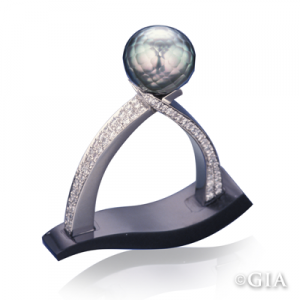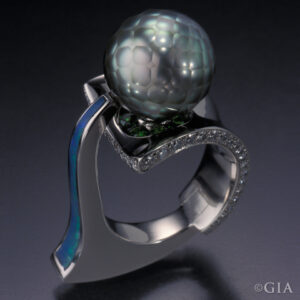The pearl has been shrouded in myth and mystery since antiquity.
The ancient Romans imagined they were the tears of gods and angels. The ancient Chinese thought they offered protection from fire-breathing dragons. And Europeans believed they symbolized modesty, chastity, and purity.
In the 20th century, the classic cultured pearl necklace became an essential fashion accessory, adorning icons of sophistication like Jackie Kennedy Onassis, Audrey Hepburn, and Coco Chanel.

Paspaley South Sea cultured pearl suite: necklace, bracelet, earring and ring. Courtesy of Fine Gems International
“Nature makes pearls, and faceting brings out their beauty,” says award-winning designer Mark Schneider, who has earned a reputation for featuring faceted cultured pearls in his work. “I take what nature creates and put my fingerprints on it.”
A GIA Pearl Identification Report for faceted cultured pearls describes them using three of GIA’s 7 Pearl Value Factors™: Size, Shape and Color. Due to the modified surface of faceted cultured pearls, the GIA reports do not describe Luster, Surface, Nacre Quality or Matching (if applicable).
The GIA Pearl Identification Report also identifies if the faceted cultured pearl is natural or cultured; the type of nucleation (bead or non-bead); mollusk (if determinable); the environment (saltwater or freshwater); and any detectable treatments. With this information, you can make your purchase with peace of mind.
Whether your taste is for the traditional or the Avant Garde, you’re sure to enjoy these unique creations.

“Equilibrium” ring has a faceted black Tahitian cultured pearl mounted in platinum. Gift of Mark Schneider.
Jewelry designer Mark Schneider says that architecture inspires his work, and his “Equilibrium” ring bears testimony. Winning first place in the 2004 American Vision Awards, Platinum Distinction category, the left and right portions of the ring shank, accented with diamonds, hold a faceted black Tahitian cultured pearl mounted in platinum. The bottom of the shank is black onyx. This ring would make a serious statement on the runway or at a red carpet gala.
Jeffrey Appling won first place in the 2007 Jewelry Arts Awards, Rings category, for this eclectic piece named “Pearl Protrusion”. The contrast is striking: a faceted white cultured pearl sits opposite a faceted black cultured pearl (in the trade, the color may be referred to as “peacock,” which has a dark green-gray to blue-gray body color and a pink to purple overtone). The shank is decorated with tsavorite garnets and pink sapphires. The inside of the ring is rounded on the bottom to make the design not only unique, but also more comfortable to wear. Intricate engraving and an unorthodox setting are the finishing touches on this unusual work.

Mark Schneider’s 2001 AGTA Spectrum Award-winning design features a faceted black Tahitian cultured pearl.
In Mark Schneider’s 2001 AGTA Spectrum Award-winning creation, a faceted black Tahitian cultured pearl holds center stage in this exquisite ring. The black opal inlay creates a waterfall effect. The bed of green tsavorite garnets bring to mind the ocean on a summer’s day.
What do you think of the faceted cultured pearl? Do you prefer the traditional un-faceted cultured pearl? Or do you like the unique, and are drawn to the unusual look of the faceted cultured pearl?



